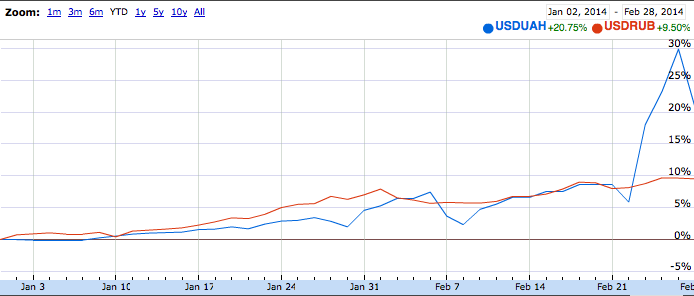Russia’s Ruble (RUB) and Ukraine’s Hryvnia (UAH) reopened for trading on the Forex market tonight, losing ground against the US Dollar (USD) in a safe haven bid seen early across the global interbank market. Early tomorrow, the equities of (presumably) both countries – most broadly represented by those stocked listed on the MICEX and UAX – will presumably open for trade.
To gain some orientation into these more parochial markets, active investors and interested onlookers are studying ETFs such as Market Vectors Russia ETF (RSX) – the #1 trending tag on Stocktwits – and the S&P Russia SPDR (RBL). If the volatility evinced by currency markets last week is any indication – particularly in the UAH as Ukraine entered the weekend tremulously balancing on new currency controls between the brink of insolvency and securing billions in IMF aid – the coming week’s trade will be one carrying enormous risk.
US Dollar/Ukrainian Hryvnia (USD/UAH) and US Dollar/Russian Ruble (USD/RUB) – YTD
Markets will undertake a process of price discovery and will eventually find clarity on the escalating conflict between Russia and Ukraine; but the path there is fraught with difficulty for traders and active investors attempting to make sense of it all: even if they’re only trying to cogently assess any emerging macro risks to their portfolio.
Assuming a diplomatic solution isn’t quickly achieved, details will continue to torrentially pour in and the fundamentals – i.e. “the facts on the ground” – will continue to shift underfoot. They will continue to be amalgamated – through old and new media alike – into narrative, which more than anything is the author of market sentiment. Markets are always guided by narrative momentum, but this relationship is rarely more apparent or important than in the binary RoRo (Risk on/Risk off) environment the prospect of pervasive geopolitical conflict and open belligerency can foster.
However global markets closed last week, tomorrow they will open caught in the grip of narratives about this conflict. And because the job of narrative – master heuristic that it is – is to disambiguate and impose cohesive order on a what is really a debilitating jumble of raw data, these narratives will be adopted as guideposts for rationality. As a result: how one thinks about “Russia-Ukraine” – moreover, what one thinks is the right way to think about “Russia-Ukraine” – will dictate how they believe markets ought to react (or if they should react, at all). But inasmuch as the narratives we create or adhere to are unique re-orderings of facts, they have the power to create irrationality: to become unmoored from the sum of the fundamentals that constitute them. When these well-crafted but not necessarily well-grounded stories multiply across market participants, the seeds of acute price inefficiencies travel with them.
So, we’re looking at collective insanity then? No: but price movements that can seem counter-intuitive – that seem like they ought not to happen given breaking news, emerging developments, or a stock or asset class’s apparent lack of connection – will happen anyway. Certain narratives will prevail: others will fail en masse; and the trades or positions opened and managed with them in mind will likewise go over the edge
As a technician, this is something that ironically receives much of my attention as I try assiduously to ignore and neutralize the role of narrative and market rationality in my own process. Whatever your approach or style, though, keep the power of narrative momentum in mind as you assess risk here. And toss any preconceived notions of what markets ought to do out the window: right now – just like before an earnings or major economic release – the safest course is to assume irrationality won’t be the exception, but the rule.
Twitter: @andrewunknown and @seeitmarket
Author holds no exposure to instruments mentioned at the time of publication. Commentary provided is for educational purposes only and in no way constitutes trading or investment advice.
Charts courtesy of Google. Flags image courtesy of weaponsman.com
Any opinions expressed herein are solely those of the author, and do not in any way represent the views or opinions of any other person or entity.









